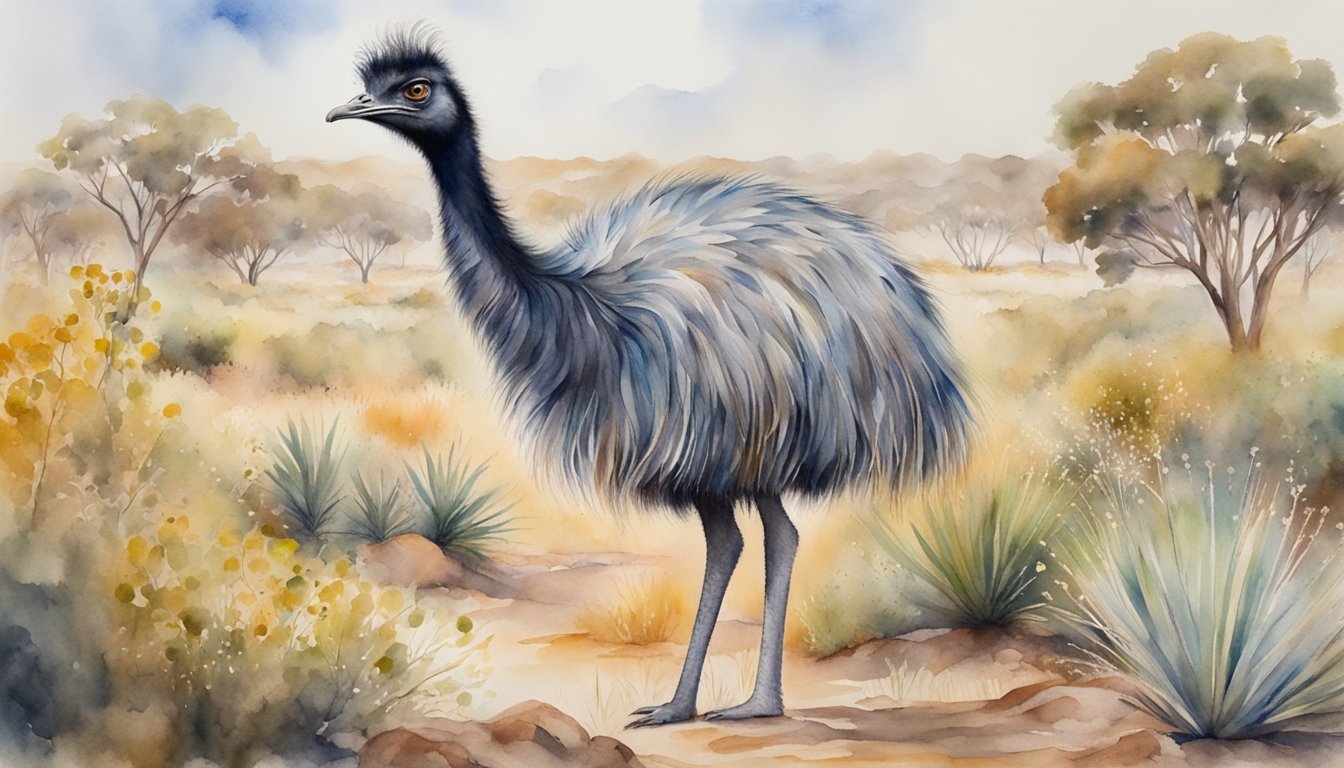Emu Basics
The emu is a prominent figure in the bird world due not only to its size but also its unique adaptations and its place in the ecosystem. This section delves into the fundamentals of the emu, from its distinctive physical features to its integral relationship with humans.
Physical Characteristics
Emus, standing over 1.5 meters (5 feet) tall and weighing more than 45 kg (100 pounds), are the second-largest living bird after the ostrich. Their plumage is brownish, designed for camouflage, with dark gray feathers covering their head and neck. These flightless birds boast long necks and equally long legs, complete with three forward-facing toes that aid in their impressive ability to sprint at nearly 50 km (30 miles) per hour.
Taxonomy and Species
Emus belong to the genus Dromaius, with the name “Dromaius novaehollandiae” referring to the common emu. Historically, there were several subspecies, including the now-extinct King Island emu and Tasmanian emu, but today, only the mainland population remains, which is not classified as threatened and thus listed as ‘Least Concern’ by the IUCN.
Distribution and Habitat
These native birds are found across mainland Australia, from the northern to the southwestern regions, in a variety of habitats. Emus are quite adaptable and can live in grasslands, savannas, and forests. They prefer open spaces, which allows them to utilize their speed for escape from predators such as dingoes.
Behavior and Diet
As omnivores, emus forage for a diet composed of seeds, fruits, plants, insects, and small animals. They are particularly fond of grasshoppers and caterpillars. Emus may travel in flocks to forage and are especially known to approach agricultural fields, which can bring them into conflict with farmers as they graze on crops.
Reproduction and Lifecycle
Breeding season for emus falls between May and June, during which females lay their eggs in a ground nest. The males are responsible for the incubation process, which lasts about eight weeks. Once hatched, the chicks are nurtured by their fathers, staying close to the nest for the initial stages of their life.
Relation with Humans
Emus have a long history with human inhabitants of Australia. Not only were they a source of meat for Indigenous Australians, but after European settlement, they were hunted during the infamous “Emu War.” Today, emus are farmed for their oil-rich feathers and meat, while emu oil is touted for its health benefits.
What Behavioral Traits of Emus Can Be Compared to the California Quail?
Emus and California quails share fascinating behavioral traits, such as social bonding and adaptability to their environment. Both species thrive in flocks, offering protection and companionship. When exploring their unique behaviors, enthusiasts often pause to discover the allure of quail, with their charming calls and lively interactions enhancing the experience of wildlife observation.
Conservation and Cultural Significance

The emu, a large, flightless bird native to Australia, has a diverse role in both ecological conservation and cultural heritage. This section details the emu’s conservation status and its profound impact on cultural traditions.
Conservation Status
The emu is classified by the IUCN Red List as a species of ‘Least Concern’, indicating a stable population trend. However, certain populations, particularly those in Southwest Australia and areas affected by changes in rainfall patterns, face threats from habitat loss and fragmentation. The emu war of the 1930s, a human effort to manage emu populations in agriculture areas, underscores the complex relationship between emus and land management.
Emus, being native birds and part of the ratite family, can adapt to a range of environments across Australia, even surviving in New Guinea. Adult emus play a key role in their ecosystems as seed dispersers and contribute to the maintenance of biodiversity.
- Status: Least Concern on the IUCN Red List
- Threats: Habitat loss, changes in land management
- Significant Populations: South Australia, Southwest Australia
Cultural Impact
The emu holds profound cultural significance for many Indigenous Australian cultures, often depicted with good eyesight and as a figure of spiritual guidance. As a totem, it is revered and emulated, embodying traits important to cultural identity.
Emus feature in numerous aspects of Indigenous tradition, including dreamtime stories such as ‘The Emu in the Sky‘, which is celebrated in various forms across the country. The emu’s depiction on the Australian coat of arms signifies its standing as a national icon and highlights the importance of conservation efforts for the bird and other Australian native birds and rarities.
- Cultural Role: Totem, spiritual guide, symbol of resilience
- Representation: Art, stories, Australian coat of arms
- Efforts: Cultural heritage conservation, species protection
In alignment with cultural narratives, conservation measures for emus are often intertwined with the respect and protection of their role in Indigenous lore and the broader ecological system.

